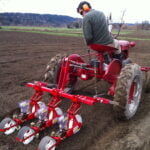Understanding Tree Calipers: Measuring and Sizing Trees with Accuracy

When it comes to measuring and sizing trees with accuracy, one essential tool comes to mind - tree calipers. These handy devices are specifically designed to measure the diameter of trees, providing valuable information for various purposes such as tree maintenance, planning, and research. In this article, we will delve into the world of tree calipers, exploring what they are, why they are important, the different types available, how to use them effectively, and the advantages they offer. So let's get started on understanding tree calipers and their significance in accurately measuring and sizing trees.
- What are tree calipers?
- Importance of accurate measurement and sizing of trees
- Types of tree calipers
- Size and measuring range of calibrators
- Step by step to measure a tree with calipers
- Important considerations when using tree calipers
- Advantages of using tree calipers
- Conclusions and recommendations for accurate measurement and sizing of trees
What are tree calipers?
Tree calipers, also known as tree diameter tapes or tree diameter gauges, are specialized tools used to measure the diameter of tree trunks. They consist of a graduated tape or scale, typically made of durable material such as metal or fiberglass, along with a movable jaw or caliper that allows for accurate and precise measurements.
These calipers are designed to be wrapped around the tree trunk, with the jaws securely fastened on both sides of the trunk. The measurement reading is then taken from the graduated scale or tape, indicating the diameter of the tree at that specific point. Tree calipers can have either metric or imperial units of measurement, making them versatile and suitable for various geographical regions.
Importance of accurate measurement and sizing of trees
Understanding the measurements and dimensions of trees is crucial for several reasons. Whether you are an arborist, a forester, a researcher, or simply a tree enthusiast, accurate tree measurements provide valuable insights into the health, growth, and overall condition of trees.
Measuring tree caliper can aid in assessing the tree's age, determining its growth rate, evaluating the success of tree planting programs, and monitoring potential changes in tree size over time. Additionally, precise tree measurements are essential for determining appropriate tree spacing, identifying potential hazards such as leaning or unbalanced trees, and planning tree care or removal.
Furthermore, accurate tree measurements are of utmost importance in various research studies related to forestry, climate change, biodiversity, and ecosystem dynamics. These measurements allow scientists and researchers to analyze and compare data across different tree populations, helping them make informed decisions and draw meaningful conclusions.
Types of tree calipers
There are several types of tree calipers available in the market, each designed to cater to specific measurement needs. The most common types include:
1. Vernier Tree Calipers: Vernier calipers, also known as dial calipers, feature a sliding jaw that moves along a precision scale. These calipers provide accurate measurements with high precision, making them ideal for tasks that require extreme accuracy.
2. Digital Tree Calipers: Digital calipers utilize digital technology to provide precise and instantaneous measurements. These calipers often come with an LCD screen that displays the measurement in digital form, making them easy to read and record.
3. Tape Tree Calipers: Tape calipers are designed like a tape measure, with a flexible tape that can be wrapped around the tree trunk. These calipers are typically made of metal or fiberglass, making them durable and suitable for outdoor use.
4. Folding Tree Calipers: Folding calipers are compact and portable, as they feature a hinged design that allows them to fold up for easy storage. These calipers are convenient for fieldwork or when working in tight spaces.
Size and measuring range of calibrators
Tree calipers come in various sizes and ranges of measurement, allowing users to select the most appropriate tool for their needs. The size of the caliper jaws determines the range of tree diameters that can be measured accurately.
For smaller trees, calipers with a range of 6 to 18 cm are commonly used. These calipers are suitable for measuring young trees, saplings, and smaller ornamental trees. On the other hand, larger calipers with a range of 18 to 35 cm are used for measuring mature trees and larger specimens.
It is important to choose a caliper size that corresponds to the expected tree diameter range, ensuring accurate and precise measurements. Using a caliper that is too small or too large for the tree being measured can result in inaccurate readings and compromised data.
Step by step to measure a tree with calipers
Measuring a tree with calipers requires a systematic approach to ensure accurate and reliable results. Here is a step-by-step guide on how to measure a tree using tree calipers:
1. Select the appropriate size of calipers based on the expected diameter range of the tree.
2. Hold the calipers with the jaws open and position it around the tree trunk at the desired height for measurement.
3. Align the jaws of the calipers on both sides of the tree trunk, ensuring they are perpendicular to the trunk and not twisted or slanted.
4. Close the jaws of the calipers gently but firmly until they make contact with the tree trunk. Be careful not to compress the bark or damage the tree in any way.
 Market Gardening Supplies: Stay Updated with the Latest News
Market Gardening Supplies: Stay Updated with the Latest News5. Read and record the measurement indicated on the scale or tape of the calipers. If using digital calipers, note the measurement displayed on the LCD screen.
6. If measurements need to be taken at multiple heights along the tree trunk, repeat the process at each desired height, ensuring consistency in the positioning of the calipers.
7. For trees with irregular shapes or tapering trunks, it may be necessary to take multiple measurements at different heights and average them to obtain a more representative diameter.
Important considerations when using tree calipers
While tree calipers are reliable tools for measuring tree diameter, it is important to keep certain considerations in mind to ensure accurate and consistent results. Here are some important factors to consider when using tree calipers:
1. Proper positioning: Positioning the calipers correctly around the tree trunk is crucial for obtaining accurate measurements. Ensure that the jaws of the calipers are aligned perpendicular to the trunk and not twisted or tilted.
2. Avoid compression: When closing the jaws of the calipers, be careful not to compress the bark or apply excessive pressure that may alter the measurement. A gentle but firm contact with the tree trunk is sufficient for accurate readings.
3. Consistency: Maintaining consistency in the positioning and technique throughout the measurement process is essential. This ensures reliable data and facilitates comparisons between different trees or subsequent measurements of the same tree.
4. Multiple measurements: For trees with irregular shapes, forks, or tapering trunks, taking multiple measurements at different heights along the trunk can provide a more representative average diameter.
5. Calibration: Regularly calibrate the calipers to ensure their accuracy. Over time, calipers may become worn or lose their precision, leading to inaccurate measurements. Checking and adjusting the calibration periodically will help maintain optimal performance.
Advantages of using tree calipers
The use of tree calipers offers several advantages when it comes to measuring and sizing trees accurately. Here are some notable benefits of using tree calipers:
1. Precision: Tree calipers provide precise measurements, allowing for accurate determination of tree diameter. This precision is essential for various applications, such as tree management, research, and planning.
2. Versatility: Tree calipers come in different types and sizes, catering to various measurement needs. Whether it is measuring small ornamental trees or large forest trees, there is a caliper available to suit the specific requirements.
3. Efficiency: With the use of tree calipers, measuring the diameter of trees becomes a quick and straightforward process. The calipers provide instant measurements, reducing the time and effort required compared to alternative methods.
4. Portability: Many tree calipers are lightweight and portable, making them convenient for fieldwork or when working in various locations. They can be easily carried in a tool bag or pocket, ready for use whenever needed.
5. Data consistency: The use of standardized calipers ensures consistency in data collection and comparisons. By using the same measurement tool across different tree populations or over time, data can be gathered and analyzed consistently, allowing for accurate trend analysis and decision-making.
Conclusions and recommendations for accurate measurement and sizing of trees
As we have explored in this comprehensive guide, tree calipers are invaluable tools for accurately measuring and sizing trees. They provide precise measurements, versatility in different measurement ranges, and several advantages in terms of efficiency and data consistency.
When measuring trees with calipers, it is essential to pay attention to proper positioning, avoid bark compression, maintain consistency in technique, take multiple measurements when necessary, and regularly calibrate the calipers for optimal accuracy.
By incorporating tree calipers into tree management, research, and planning activities, one can obtain valuable insights into tree health, growth rates, and overall tree conditions. So, for anyone involved in the world of trees, understanding and utilizing tree calipers is a must.
In conclusion, tree calipers are essential tools for anyone seeking to measure and size trees with accuracy. Through their precise measurements and versatility, they provide valuable data for tree management, research, and planning purposes. So, if you want to delve deeper into understanding trees and their dimensions, don't forget to embrace the power of tree calipers. They are indeed a game-changer when it comes to accurately measuring and sizing trees.
 Seed Funnel: Your Guide to Jang's Fun and Effective Planting Strategy
Seed Funnel: Your Guide to Jang's Fun and Effective Planting Strategy
Leave a Reply